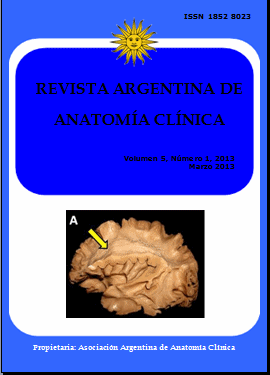PECTORO-EPICONDYLARIS: A RARE EXTENSION OF THE PECTORALIS MAJOR MUSCLE. Pectoro-epicondilaris: Una rara extensión del músculo pectoral mayor
DOI:
https://doi.org/10.31051/1852.8023.v5.n1.14049Palabras clave:
Pectoralis major, pectoro-epicondylaris, medial intermuscular septum, medial epicondyle, pectoral mayor, pectoro-epconcilaris, septo intermuscular medial, epicóndilo medialResumen
El músculo pectoral mayor es propenso a varias incongruencias morfológicas. Diferentes deslizamien-tos musculares son comunes entre ellos. Sin embargo, durante la disección rutinaria de un cadáver masculino de 55 años por estudiantes de pregrado, se encontró una variante rara de la extensión tendinosa del músculo pectoral mayor. Surgía de la lámina profunda del tendón muscular bilaminar cerca de su inserción en el húmero. En su camino a unirse al tabique intermuscular medial del brazo y finalmente al epicóndilo medial del húmero, cruzó todas las estructuras en la parte delantera del brazo de lateral a medial. Considerando la extensión tendinosa de forma proximal, no se observó formación muscular separada. Esta variante de deslizamiento puede ser nombrada como músculo pectoral epicondilario. El conocimiento de esta variación particular puede ser de especial interés para los radiólogos y médicos en procedimien-tos tales como transformación de músculo, trasplante de tendón y uso en los colgajos miocutáneos durante cirugías reconstructivas.
The pectoralis major muscle is prone to various morphological incongruities. Variant muscular slips are common among them. However during routine dissection for undergraduate students in a 55-year-old male cadaver, a rare variation of the tendinous extension of the pectoralis major muscle was found. It was arising from the deep lamina of the muscular bilaminar tendon close to its insertion to the humerus. On its way to be attached to the medial intermuscular septum of the arm and finally to the medial epicondyle of the humerus, it crossed all the structures in the front of the arm from lateral to medial. Tracing this tendinous extension slip proximally, no separate muscular extension was observed. this variant slip may be named as pectoro-epicondylaris muscle. The know-ledge of this particular variation could be of special interest to radiologists and clinicians in procedures such as muscle transformation, tendon transplantation and use of myo-cutaneous flaps during reconstructive surgeries.
Referencias
Al Qattan MM, Yong Y, Kpzin SH. 2009. Embryology of the upper limb. J Hand Surg 34: 1342.
Arican RY, Coskun N, Sarikcioglu L, Sindel M, Oguz N. 2006. Co-existence of the pectoralis quartus and pectoralis intermedius muscles. Morphologie 90: 157-159.
Beals RK, Crawford S. 1976. Congenital absence of the pectoral muscle. Clinical orthopaedics 119: 166.
Bergman RA, Thompson SA, Afifi AK, Saadeh FA. 1988. Compendium of human anatomic variations. Urban and Schwarzenberg, Baltimore-Munich, pp 7-8.
Bonastre V, Rodríguez-Niedenführ M, Choi D, Sanudo JR. 2002. Coexistence of a pectoralis quartus muscle and an unusual axillary arch: case report and review. Clin Anat 15: 366-370.
Carlson BM. 2004. Human embryology and developmental biology. Mosby, pp 224-225.
Di Gennaro GL, Soncini G, Andrisano A, Valdiserri L. 1998. The chondro-epitrochlearis muscle: case report. Chir Organi Mov 83: 419-423.
Flaherty G, O’Neill MN, Folan-Curran. 1999. Bilateral occurrence of a chondro-epitrochlearis muscle. J Anat 194: 313-315.
Hammad RB, Mohamed A. 2006. Unilateral four-headed pectoralis muscle major. Mcgill J Med 9: 28-30.
Jeorge MB, Jose MG. 2009. Chondro-fascialis Versus Pectoralis Quartus. Clin Anat 22: 871–872.
Lama P, Potu BK, Bhat KM. 2010. Chondro-humeralis and axillary arch of Langer: a rare combination of variant muscles with unique insertion. Rom J Morphol Embryol 51: 395-397.
Loukas M, Louis RG Jr, Kwiatkowska M. 2005. Chondro-epitrochlearis muscle, a case report and a suggested revision of the current nomenclature. Surg Radiol Anat 27: 354-356.
Loukas M, South G, Louis RG Jr, Fogg QA, Davis T. 2006. A case of an anomalous pectoralis major muscle. Folia Morphol (Warsz) 65: 100-103.
Spinner RJ, Carmichael SW, Spinner M. 1991. Infraclavicular ulnar nerve entrapment due to a chondro-epitrochlearis muscle. J Hand Surg Br 16: 315-317.
Standering S. 2005. Gray’s Anatomy. The anatomical basis of clinical practice, 39th ed, Churchill Livingstone, Elsevier, pp 833-834.
Shetty SD, Nayak SB, Kumar N, Somayaji SN, Mohandas Rao KG. 2011. Costodorsalis – an Additional Slip of Pectoralis Major Muscle - a Case Report. Int J Morphol 29: 409-411.
Sweeney LJ. 1998. Basic concepts in embryology. McGraw-Hill. pp 136-138.
Turgut, H, Anil A, Peker T and Barut C. 2000. Insertion abnormality of bilateral pectoralis minimus. Surg Radiol Anat 22: 55-57.
Tubbs RS, Shoja MM, Shokouhi G, Loukas M, Oakes WJ. 2008. Insertion of the pectoralis major into the shoulder joint capsule. Anat Sci Int 83: 291-293.
Voto SJ, Weiner DS. 1987. The chondro-epitrochlearis muscle. J Pediatr Orthop 7: 213-214.
Descargas
Publicado
Número
Sección
Licencia
Los autores/as conservarán sus derechos de autor y garantizarán a la revista el derecho de primera publicación de su obra, el cuál estará simultáneamente sujeto a la Licencia de reconocimiento de Creative Commons que permite a terceros compartir la obra siempre que se indique su autor y su primera publicación en esta revista. Su utilización estará restringida a fines no comerciales.
Una vez aceptado el manuscrito para publicación, los autores deberán firmar la cesión de los derechos de impresión a la Asociación Argentina de Anatomía Clínica, a fin de poder editar, publicar y dar la mayor difusión al texto de la contribución.



